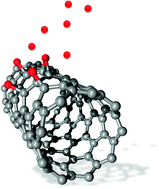Modelling of the reactivity and stability of carbon nanotubes under environmentally relevant conditions
Abstract
The remarkable properties of carbon nanotubes have made them the preferred candidate for a number of exciting new technologies, and the intense focus of an enormous volume of scientific research. Much of this work is performed under highly idealized conditions, and less attention has typically been given to understanding what happens when carbon nanotubes are exposed to more realistic conditions, such as those typical in everyday devices. One of the most important aspects of this real world exposure will be the interaction of carbon nanotubes with our atmosphere. Adsorption of air will impact the stability of the carbon nanotubes, and may have undesirable consequences for the fundamental properties and the reliability of the device. Since this is a very challenging problem to address using experimental methods, it is often appropriate to begin by using theory and simulation. Presented here is a general analytical model for describing the thermodynamic stability of carbon nanotubes in the presence of gas adsorbates. This model is used to examine the stability of nanotubes in air, as a function of the relative humidity, but is equally applicable to any gaseous environments given suitable input parameters.


 Please wait while we load your content...
Please wait while we load your content...